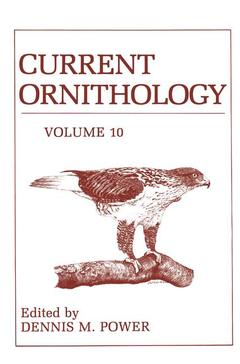Description
Current Ornithology, 1993
Volume 10
Current Ornithology Series, Vol. 10
Language: English
Subjects for Current Ornithology:
Keywords
anatomy; behavior; biology; conservation biology; ecology; evolution; migration; ontogeny; ornithology; phylogeny; physiology; primates; species diversity
Publication date: 02-2012
398 p. · 15.2x22.9 cm · Paperback
398 p. · 15.2x22.9 cm · Paperback
Description
/li>Contents
/li>
Detailing novel research methods, this compilation presents major advances in fundamental aspects of phylogeny, mating, parental care, the trophic structure of Raptor communities, demography, behavioral ecology, species diversity, and the evolution of avian ontogenies. The book also features the most extensive list of international references available on raptor diet and feeding behavior and nocturnality. Current Ornithology is the only English-language publication currently devoted exclusively to extensive reviews and synthesis of topics pertaining to all aspects of the biology of birds. Chapters fall under such diverse rubrics as ecology, evolution, behavior, phylogeny, behavioral ecology, anatomy and physiology, and conservation biology. All authors are leading authorities on their subjects, and each chapter is refereed by experts in the topics covered. Although all chapters focus primarily on birds, some topics, such as the social cognition of birds as compared to primates (Volume 13), have significant application to disciplines outside of ornithology. CurrentOrnithology aims to provide an accessible, up-to-date, accurate source of data and to contribute to conceptual generalization and unification across the biological sciences.
1 The Role of Phylogenetic History in the Evolution of Contemporary Avian Mating and Parental Care Systems.- 1. Introduction.- 2. Paternal Care in Ratites and Tinamous.- 3. Clutch Size in Shorebirds.- 4. Classical Polyandry in Shorebirds.- 5. Classical Polyandry in a Cuckoo.- 6. Classical Polyandry: General Conclusions.- 7. Cavity Nesting and Roosting by Coraciiform, Piciform, and Trogoniform Birds.- 8. Nocturnal Incubation by Males in Cuckoos and Woodpeckers.- 9. Phylogenetic Components of Cooperative Breeding.- 10. General Conclusions.- References.- 2 Trophic Structure of Raptor Communities: A Three-Continent Comparison and Synthesis.- 1. Introduction.- 2. Materials and Methods.- 3. Results.- 4. Conclusions.- Appendices.- References.- 3 Matrix Methods for Avian Demography.- 1. Introduction.- 2. Setting Up Matrix-Based Models.- 3. Calculating Demographic Parameters.- 4. Fitness, Sensitivities, and Elasticities.- 5. Variances and Confidence Limits.- 6. Applications to Field Studies andExisting Models.- 7. A Case Study—Florida Scrub Jays.- 8. Summary and Synthesis.- Appendix: Glossary of Terms.- References.- 4 Nocturnality in Colonial Waterbirds: Occurrence, Special Adaptations, and Suspected Benefits.- 1. Introduction.- 2. Nocturnal Habits.- 3. Special Adaptations.- 4. Suspected Benefits.- 5. Discussion and Conclusions.- References.- 5 Latitudinal Gradients in Avian Species Diversity and the Role of Long-Distance Migration.- 1. Introduction.- 2. Methods.- 3. Results.- 4. Discussion.- 5. Summary.- References.- 6 Evolution of Avian Ontogenies.- 1. Introduction.- 2. Ontogeny and Time.- 3. Eggs, Clutch Size, and Incubation.- 4. Postnatal Growth and Ontogeny.- 5. Ecological Constraints on Developmental Mode.- 6. The Embryonic Development of Integument.- 7. The Development of the Skeleton.- 8. The Development of the Brain.- 9. The Development of the Intestine.- 10. Conclusions and Summary.- References.
© 2024 LAVOISIER S.A.S.
These books may interest you

Current Ornithology 52.74 €

Current Ornithology 210.99 €

Handbook of Bird Biology 125.33 €

